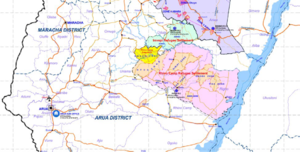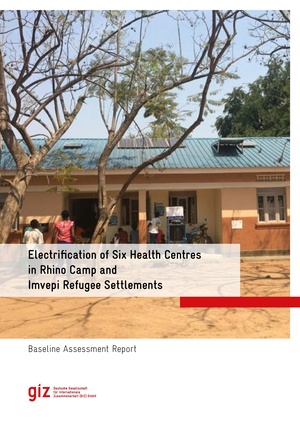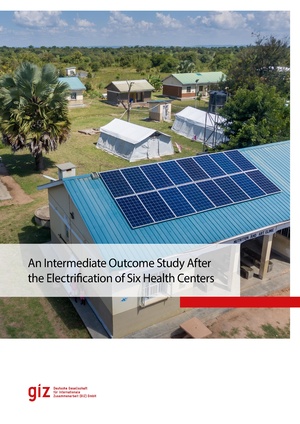Knowledge fuels change - Support energypedia!
For over 10 years, energypedia has been connecting energy experts around the world — helping them share knowledge, learn from each other, and accelerate the global energy transition.
Today, we ask for your support to keep this platform free and accessible to all.
Even a small contribution makes a big difference! If just 10–20% of our 60,000+ monthly visitors donated the equivalent of a cup of coffee — €5 — Energypedia would be fully funded for a whole year.
Is the knowledge you’ve gained through Energypedia this year worth €5 or more?
Your donation keeps the platform running, helps us create new knowledge products, and contributes directly to achieving SDG 7.
Thank you for your support, your donation, big or small, truly matters!
Electrification of Six Health Centres in Rhino Camp and Imvepi Refugee Settlements
Background
Uganda is one of the top-most refugee hosting countries worldwide currently, hosting approximately 1.5 million refugees, mostly from South Sudan, the Democratic Republic of Congo (DRC), Burundi, Rwanda and Somalia. Refugees live mostly in settlements along with rural host communities across twelve out of 134 districts (besides Kampala Municipality) which are among the poorest and least developed in the country.
Access to and use of energy is essential in humanitarian response, and to longer-term sustainable development. Therefore, the lack of sufficient quality energy products and services grossly limits opportunities to meet basic needs and strive for self-reliance. Shortfalls put people at risk, for instance, in the areas of basic health care, education, and jobs and livelihoods including income generation activities.
Many health centres in the refugee hosting districts of Uganda have been equipped with off-grid solar (OGS) PV installations over the recent years through various programmes and partners. These are supposed to provide power for lighting, vaccine fridges, medical appliances, phone charging among others.
Despite these relative successes, many of the same facilities lack reliable and sufficient energy access as of today. For instance, some energy systems had not been sized adequately and therefore provide power for only some of several medical appliances and/or often for a few hours only. Furthermore, once these installations have been handed over to the respective stakeholders, the management of the systems has mostly been poor or inexistent. Operations and maintenance of (faulty) components which would guarantee the operability of these systems, is not been carried out adequately due to poor planning, prioritization, funding and technical capacity.
Given this background, the GIZ projects Energy Solutions for Displacement Settings (ESDS) and Energising Development (EnDev) intended to provide and install well designed OGS PV Systems for six purposefully selected health centres located within Rhino Camp and Imvepi Refugee Settlements in Terego and Madi Okollo districts of Uganda in 2021. This article provides a summary of the baseline assessment results that was conducted in 2021 prior to the electrification of these six health centers, as well as an intermediate outcome assessment that was conducted ten months after the initial electrification.
Baseline Assessment Results
Five health facilities fall under the direct managing authority of the Ministry of Health (MOH) and one health facility is under the direct managing authority of International Rescue Committee (IRC). Regardless of managing authority, all health facilities receive support – technical, infrastructural, staffing, and other – from the Ministry of Health, a multitude of implementing partners, and UNHCR. The managing authority of health facilities have important implications on the engagement of stakeholders for ownership, maintenance, and sustainability of the OGS PVS assets.
General health facility characteristics (data collected from 2021 Baseline Health Facility Survey).
| Health Center | Refugee Settlement | District | Health Facility Level | Managing Authority | Years of Service | Catchment Population | ||
| Refugee | Host | Total | ||||||
| Imvepi HC II | Imvepi | Terego | HC II | MOH | 26 | 19,668 | 3,224 | 22,892 |
| Yinga HC III | Imvepi | Terego | HC III | MOH | 25 | 10,813 | 7.351 | 18,164 |
| Siripi HC III | Rhino Camp | Terego | HC III | MOH | 27 | 13,090 | 5,500 | 18,590 |
| Ofua HC III | Rhino Camp | Terego | HC III | IRC | 5 | 26,952 | Unknown | Unknown |
| Ocea HC II | Rhino Camp | Madi Okollo | HC II | MOH | 26 | 18,428 | 3,729 | 22,157 |
| Odoubu HC II | Rhino Camp | Madi Okollo | HC II | MOH | 29 | 12,461 | 4,500 | 16,961 |
Status of Electrification
None of the six health centres were connected to the national or community grid. However, all six health centres had at least one partially functioning off-grid solar PV system (OGS PVS) and three health facilities had at least one diesel generator. Five had standalone EPI solar refrigerators to store and ensure cold chain of vaccines and oxytocin. Four had a We Care Solar installed to charge small devices, such as the HemoCue, Foetal Doppler, and mobile phone, and only three of the We Care Solar are functional as the battery of the We Care Solar was stolen at one facility. Finally, two health facilities had Mobile Power (MoPo) power banks to provide additional power.
Electricity and Health Service Delivery at the Health Centers
According to the five facility in-charges under MOH, the first solar panels were installed when the health facilities were established for the arrival of the first wave of refugees from South Sudan over 20 years ago. Multiple partners, including Care International, Danish Refugee Council, and UNICEF, have since donated and installed different OGS PVS in select wards/ departments/ units and staff quarters.
While each health facility appears to have many OGS PVS, few of them are fully functional. Healthcare workers report frequent interruptions of electricity at the health facility and have developed multiple strategies to mitigate the impact of energy deficit on health service delivery. These mitigation strategies are categorized into four main categories: conserving energy for emergency use, finding alternative systems for energy, use of manual, non-electric methods in consultation, diagnostic, sterilization of equipment, and reporting, improvising locale of service delivery to access energy (e.g., moving patient to another ward to access lighting or electricity) and patient referral to another health facility or sending out patient samples for analysis at another laboratory.
Maintenance of the energy systems
For diesel systems, all three health facilities reported having a routine preventive maintenance programme. However, they do not have their own strategies for repair and replacement but rather report to donors in such cases. Only one facility had trained staff on maintenance and one reported on having an O&M manual.
For solar systems, 3/6 reported having a routine preventive maintenance programme for their OGS PVS. 1/6 reported receiving maintenance support from an external technician, 2/6 reported performing on-site cleaning of the solar arrays, but without a specialized technician. If there were problems with the solar systems at the health facility, 2/6 facilities said they would call the donor for replacement and 4/6 facilities said they did not have a formalized system in place. None of the facilities reported having staff trained on how to maintain a solar system and one health facility (1/6) reported having an O&M manual for the solar system.
Ownership of Solar Systems
There is limited sense of ownership for the existing OGS PVS with the exception of the Mobile Power charging stations. In case of any failure, the health facility’s strategy is to call the district or the partner for help and replacement. According to several healthcare workers, capacitating the staff to look after the solar systems can help them feel ownership and responsibility towards these assets.
Capacity building for maintenance of the solar systems
None of the health centres are capacitated to provide routine maintenance of the solar systems and do not have designated staffs for O&M of the existing OGS PVS. In general, interviewed healthcare workers and HUMC members showed willingness to learn basic O&M skills. The District Health Officer noted that Arua Regional Referral Hospital’s equipment maintenance unit has existing capacity and expertise which could be leveraged on.
Funding for maintenance, repair, and replacement of solar systems
The primary source of funding is donors grants and apart from that two additional sources like Capital Development Fund and the District Development Equalization grant were identified. For health facilities managed by MOH, the funding sources include: Primary Health Care (PHC) Fund and Results-Based Financing.
As a result of limited funding opportunities and the recognition that repairs and replacements of solar components, such as batteries will exceed what is available from the PHC funds, HUMC, health facility staff, and district health officers feel that GIZ should budget funds to support the maintenance of OGS PVS. HUMC and healthcare workers are eager for support to initiate income-generating activities in order to generate funds to support the minor maintenance and repair of the solar systems. Each site had its own ideas of what would work in its setting. Notably, these income-generating activities would need an injection of start-up capital in order to be functionalized.
Intermediate Outcome Assessment Results
Energy generation and consumption
A total of 24 KWp solar and 178KWh battery storage was installed across the six health centers.
| Health Center | Solar capacity (KW) | Estimated Annual energy generation potential (KWh) | 2021 energy consumption (Kwh) | 2022 energy consumption (KWh) |
| Imvepi HC II | 3.3 | 6000 | 1358 | 1752 |
| Yinga HC III | 2.7 | 5000 | 593 | 158 |
| Siripi HC III | 3.3 | 6000 | 590 | 1130 |
| Ofua HC III | 6.6 | 12000 | 2011 | 4718 |
| Ocea HC II | 4.4 | 8000 | 2052 | 1080 |
| Odoubu HC II | 3.3 | 6000 | 1108 | 2112 |
The estimated total annual energy generation capacity across the six health centers was 43MWh, although the average annual consumption was only 7.6 MWh in 2021, and this increased to 10.95 MWh in 2022. Ofua and Oduobo HCs saw the biggest increase in consumption, as more electrical equipment was tested. In Yinga, the Remote Monitoring System (RMS) showed a marked decrease in consumption, but this was later attributed to network interruptions that affected the logging of data. Overall, all the systems are still being used below the design capacity, and there is room for addition of more electrical equipment.
Key Findings on service delivery in comparison to baseline study
The study noted a reduction in the numbers of consultations (patient visits) progressively from 2020 to 2022, with Yinga recording the largest reduction of 36%. Reductions in consultations could be attributed to the existence of COVID 19 which limited movement.
The ratio of full-time clinicians per 10000 population slightly increased in 4 out the 6 Health centres, most notably in Oduobo and Yinga HC (from 5.2 in 2021 to 6.5 in 2022) and Ofua HC (from 6.1 in 2021 to 7.3 in 2022). Some of the interviewed health workers mentioned availability of energy, especially in the staff quarters, as a key motivation for staff retention.
Lastly, there was an increase in services offered across all the six health centers, with Oduobo HC recording the highest increase of six additional services, mainly related to laboratory testing. Some of the notable services included addition of a full-time pediatric ward at four of the HCs, Ziehl Neelsen test for TB and Gene expert for drug resistance TB, as well as a blood transfusion fridge at Ofua, Yinga and Oduobo. The increase in the provision of some of the health services can be attributed to the availability and improved reliability of solar power, which in turn resulted in increased use of powered hospital appliances and powered lab equipment.
Operations and maintenance
O&M of the solar PV system was still low in all the HCs, although the contractor provided training on the basics of the solar system maintenance. The study established that only Ofua HC had a professional technician who could operate faults in the solar system. Canteens had been constructed by GIZ at 5/6 of the HCs to take advantage of the excess power and be used to generate income to cover maintenance activities through sale of cold drinks and services like phone charging to patients and the surrounding community. GIZ also supported the Health Unit Management Committee (HUMC) to obtain a bye-law from the local government permitting them to carry out these income generating activities. At the time of the study, the operations of the canteens had not kicked off.
Recommendations
- The health unit management committee (HUMC) needs to be encouraged to budget for O&M costs to ensure that all facilities' funds are available to cover repairs and spare parts. Maintenance funds should be established upfront and be dedicated only to solar system repair. Mixing maintenance funds with general operating budgets has proven to be an ineffective model.
- The facility should select and train dedicated staff members who will be capable of handling and fixing minor faults and ensure the system is operating normally without having to contact the installation team.
- To enhance the impact of health center electrification, the installation of PV systems should prioritize HCs that operate at night and those with staff quarters because they are more likely to use the systems effectively.
- The electrification project should be integrated with approaches that can create long-lasting socioeconomic impact solutions beyond the healthcare facility as the end-users. The construction of the ‘energy kiosk’ can go a long way in ensuring ownership and accountability by its users are achieved.
The Baseline Assessment Report can be downloaded here:
The Intermediate Outcome Assessment can be downloaded here:
Partners
GIZ's Energy Solutions for Displacement Settings (ESDS) project cooperate with UNHCR to enhance the access to sustainable energy in displacement contexts, and the Energypedia page has been created to share learnings across various practitioners to spur the development of clean energy solutions.























